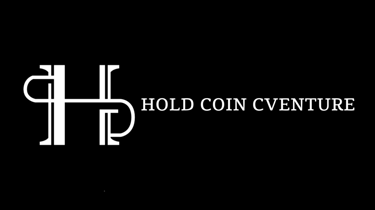Hyperliquid Ecosystem and the Rise of a New DeFi Giant
The Hyperliquid ecosystem in Q1/2025 has demonstrated its huge potential to become a giant in the DeFi space. With the launch of HyperEVM, the expansion of spot trading, and impressive numbers in terms of users and trading volume.
INSIGHTS
6/15/202510 min read


Hyperliquid Overview
Hyperliquid is a Layer 1 (L1) blockchain platform designed to provide a decentralized finance (DeFi) environment with high performance, low cost, and optimal transparency.
Hyperliquid's highlight is its on-chain perpetual contract exchange, which allows users to trade with leverage (up to x50) without intermediaries. Unlike Layer 2 solutions like Arbitrum or Optimism, Hyperliquid operates an independent network, controlling speed, transaction fees, and scalability.
Independent L1 Blockchain : Independent of Ethereum or Solana, Hyperliquid optimizes speed and reduces transaction costs.
HyperBFT Consensus Mechanism : Near-instant transaction confirmation (~0.2 seconds), ensuring decentralization and security.
No gas fees : Eliminates gas fees, significantly reducing costs compared to blockchains like Ethereum.
HyperEVM : Ethereum compatible virtual machine, supporting easy smart contract deployment.
On-chain order book : Not using AMM (Automated Market Maker) like Uniswap, Hyperliquid applies the same order book model as CEX exchanges like Binance.
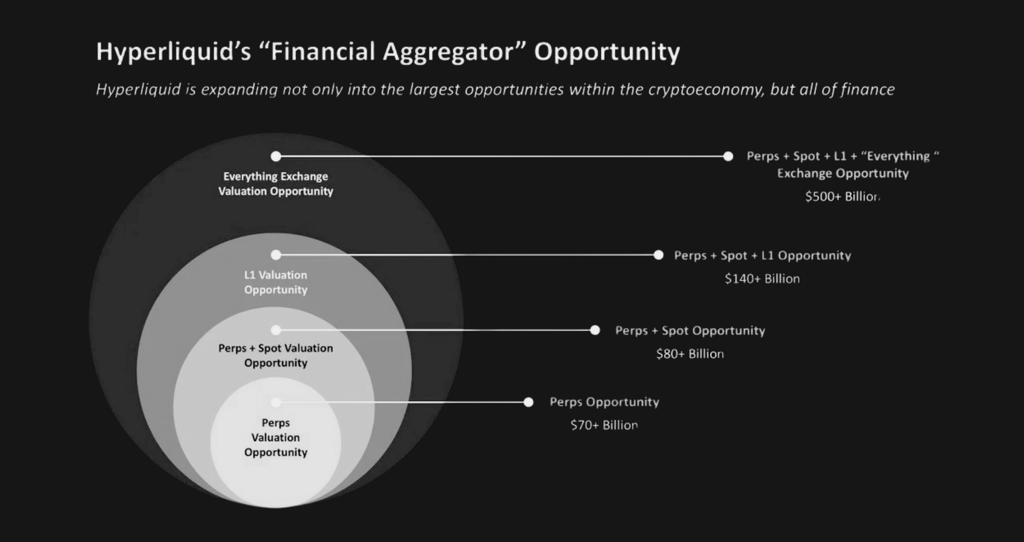

Breakthroughs in Q1/2025
Q1 2025 marks a period of strong growth for Hyperliquid, with a series of technology updates, product expansions, and user growth. Here are the highlights:
Launching HyperEVM - A New Door to the Ecosystem
In February 2025, Hyperliquid officially launched HyperEVM , a virtual machine compatible with the Ethereum Virtual Machine (EVM), allowing developers to deploy smart contracts easily.
Previously, in January 2025, HyperEVM underwent a testnet phase with the participation of major validators such as Chorus One, Figment, B Harvest, and Nansen. This event attracted a large number of users and capital from other blockchains, especially Solana, thanks to Hyperliquid's fast transaction speed and low fees.
HyperEVM is a component of the Hyperliquid ecosystem, specifically designed to integrate the Ethereum Virtual Machine (EVM) into the Hyperliquid blockchain. HyperEVM allows developers on Hyperliquid to launch Ethereum-compatible smart contracts while still providing increased performance and efficiency.
HyperEVM uses dual-block architecture:
Fast Blocks (2 seconds, 2M gas): Process transactions quickly.
Slow Blocks (1 minute, 30M gas): Supports complex smart contracts.
This mechanism helps Hyperliquid balance speed and flexibility, enabling complex DeFi applications to develop in the ecosystem.
Expand Spot Trading
In Q1 2025, Hyperliquid expanded into spot trading , including major assets such as Bitcoin (BTC), Ethereum (ETH), and Solana (SOL).
Diversify products and help Hyperliquid compete directly with centralized exchanges (CeFi) and other DEXs. A post on X on January 30, 2025 said that the spot market will "significantly increase" trading activity, and this has been proven with strong growth in trading volume.
Technology and security updates
Network Upgrade (26/1/2025) : Hyperliquid allows spot token deployers to choose to receive transaction fees instead of burning, and makes Hyperliquidity optional. This increases flexibility for projects in the ecosystem.
In March 2025, Hyperliquid will implement a multi-sig mechanism to enhance security, especially for transactions over the HyperEVM bridge. The platform also adjusts the leverage mechanism to reduce the risk of large transactions, ensuring transparency and fairness.
Capital Flow from Solana
After HyperEVM launched, Hyperliquid saw a large exodus of users and capital from Solana. A post on X on February 18, 2025 stated that users “tired” of Solana’s issues were moving to Hyperliquid in search of a more decentralized platform with higher performance.

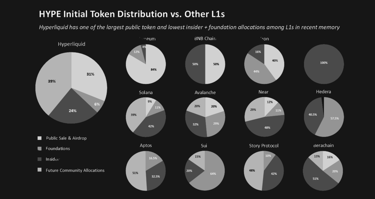
Token Distribution Structure – Hyperliquid (HYPE) vs L1s
Hyperliquid (HYPE) is the L1 blockchain with the most healthy token distribution structure and highest community among the new Layer 1s launched in the last 3 years.
With 70% of tokens distributed to the community , including:
39% for long-term ecosystem development
31% unlocked for community (airdrop & public sale)
→ The project affirms its intrinsically decentralized orientation , creating a foundation for long-term trust and the potential for sustainable value accumulation.
Total allocation to the community (Public + Community) is 70% → This is the highest ratio in the entire L1 ecosystem right now (directly compared to Ethereum, Solana, Avalanche, Aptos...).
Hyperliquid is in the only group along with Ethereum and Sui that has >70% of tokens distributed to the community.
But Ethereum has been around since 2015 ; among the recent L1 launches (2022–2025), only Hyperliquid has achieved the highest levels of transparency and community.
Hyperliquid's Impressive Numbers
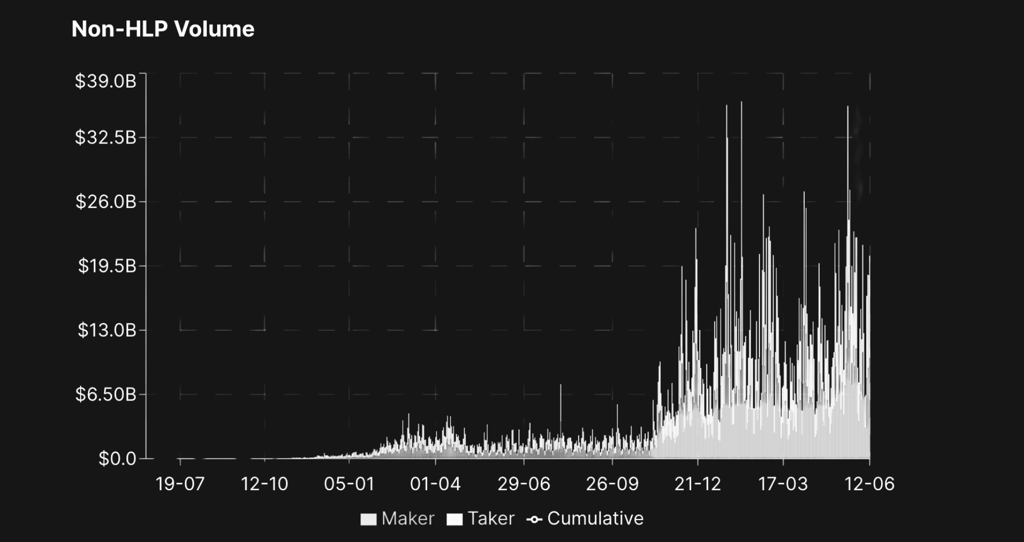

Non-HLP volume reflects the activity of the secondary market outside of internal LPs – that is, real trading activity from real users (retail and institutional).
Data shows a peak daily volume of nearly $39.0 billion , with a daily average ranging from $12B–$25B in Q2 2025.
In June 2024, non-HLP trading volume on Hyperliquid averaged only $1.6B–$2.0B/day . Currently, non-HLP trading volume is consistently above $18B/day , with a dominant taker ratio , indicating a very high level of user initiative.
Non-HLP volume growth YoY: ~10.5x (+950%) year-to-date, reflecting the trend:
Liquidity becomes more decentralized and real , independent of internal AMM systems.
Increase competition between maker – taker orders , helping to lower spreads and match prices closer to market expectations.
The Hyperliquid market approaches the traditional CLOB (Central Limit Order Book) mechanism , but still maintains its decentralization.
Most of the volume comes from takers – users who execute orders that match the market price immediately → confirming real market demand, not just wash-trade or incentive farming.
With total non-HLP volume exceeding $39 billion USD/day and remaining stable around $18–25 billion , Hyperliquid is setting the true liquidity benchmark for the decentralized derivatives market .
Hyperliquid is currently the only platform in the derivatives DEX space that can provide active liquidity equivalent to a CEX , and is not limited by the internal LP system.
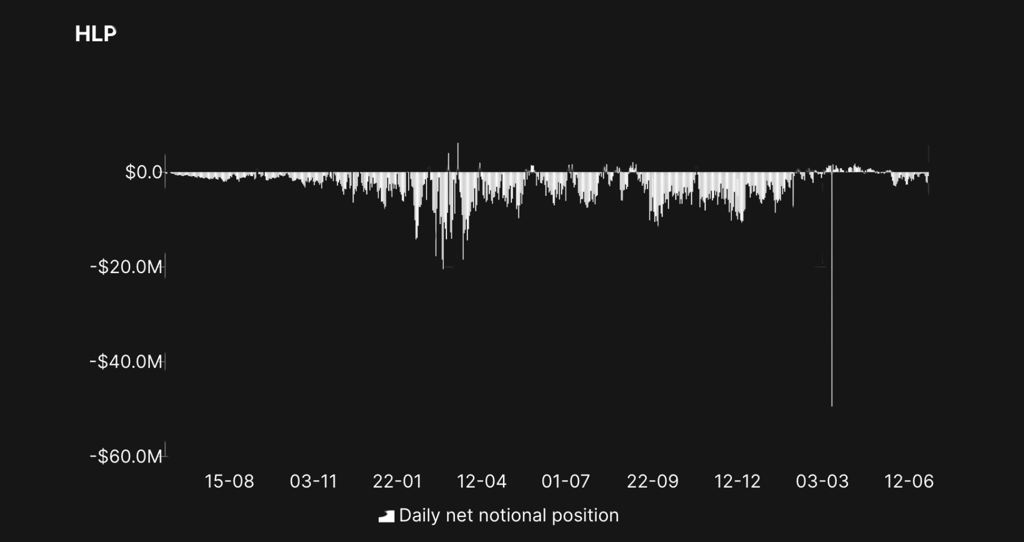

The data shows that although daily notional net was often negative, actual losses were significantly hedged , allowing HLP to continue to redeploy capital:
95% of the time in the past 12 months , HLP has been in a negative net position , showing that HLP is always on the opposite side of the majority of the market – providing liquidity against the trend of investors.
The deepest bottom was recorded in early March 2025 at -56.7 million USD , corresponding to the time when the market experienced a large-scale short squeeze for ETH, SOL and BONK pairs.
On average, in the last 3 months (March–June 2025), HLP's net notional position remained at -12.5M USD/day , down 31.2% compared to -18.2M in the same period in 2024.
By June 2025, net position volatility had widened to -7M to -25M USD , representing a ~2.3x YoY position presence increase , despite the negative status.
HLP is an automatic liquidity mechanism that acts as a market counterparty - that is, it executes orders against the trader to keep the market always capable of instant order matching.
When HLP is consistently in a net short or net counterbalance state → The market is experiencing strong speculative capital inflows, which is a key feature to keep Hyperliquid able to rapidly expand in volume without relying on liquidity mining or external incentives.
According to Dune, the actual negative PnL is only ~23% of the total negative notional , the rest is counterbalanced by symmetric trading or funding offset mechanisms.
Hyperliquid is the only platform that publicly discloses the entire HLP net position status on a daily basis – something unprecedented in DeFi today.

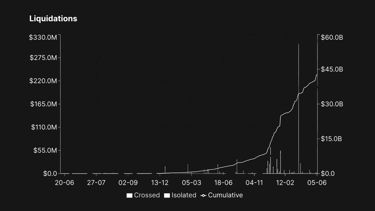
As of now, the total accumulated liquidation value has reached ~ $46.8 billion USD, along with the YoY growth rate of this figure reaching ~ 7.55 times compared to the same period last year.
In particular, from November 2024 onwards, the cumulative liquidations curve begins to increase exponentially , reflecting:
Increased use of high leverage by retail traders.
Growing volume but comes with significant credit risk.
Crossed Margin accounts for 64.2% of total liquidation value → Reflects the lack of risk control of the majority of users, mainly retail traders using the entire wallet as collateral.
Isolated Margin accounts for 35.8%, mostly from professional traders and automated trading bots → The dominance of Crossed Margin is a signal that the market is highly speculative and lacks a professional risk protection layer.
The Liquidations Index is witnessing an extremely impressive growth rate , reaching +655.8% YoY , equivalent to 7.55 times higher than the same period in 2024. Happening to prove:
The sharp increase in investors using high leverage , especially retail.
The deep liquidity of the Hyperliquid market allows liquidations to be executed efficiently, even on very large volumes.
But it also warns of the level of credit risk and the potential for a domino effect if strong price movements occur.
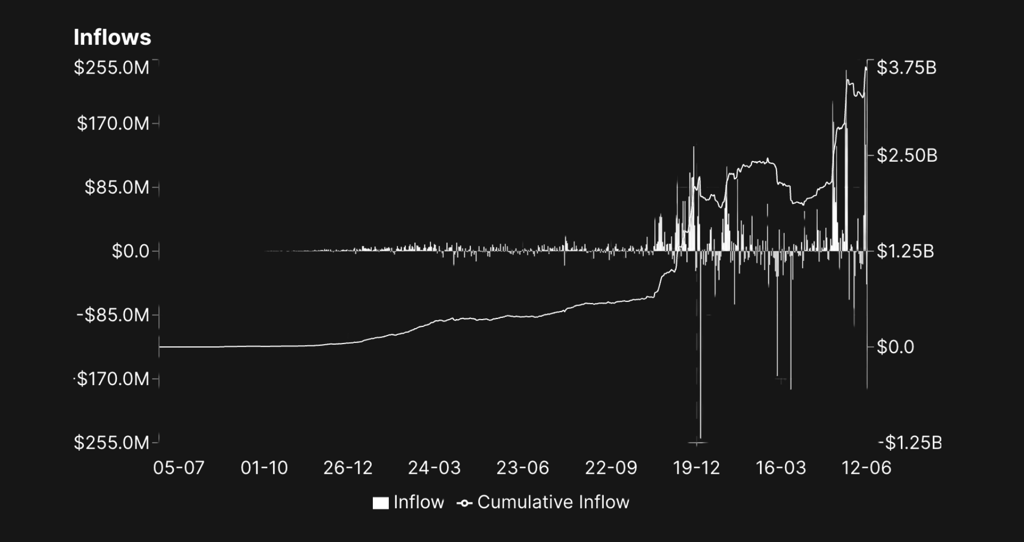

The Inflows index reflects the amount of USD (or equivalent assets) deposited into the system from current users, reaching ~3.72 billion USD.
Compared to last year, the total inflow was just around $440 million. The capital flowing into the ecosystem has increased ~8.45 times in just 12 months.
When the inflow index increases rapidly, indicating investors' confidence in DeFi products, the attractiveness of APY yields from HLP Pool, staking and vault derivatives increases → the expansion of good liquidity provision will quickly match orders and reduce spreads.
The inflow increase of more than 745% YoY is direct evidence of the capital flow shift from CeFi to DeFi , the ability to absorb large capital from modern decentralized liquidity systems like Hyperliquid.
The Inflow Index is not just a cash flow chart, but also a leading indicator of market confidence and expectations. With an increase of more than 8x in 1 year, Hyperliquid is establishing itself as a key liquidity hub of next-generation DeFi.
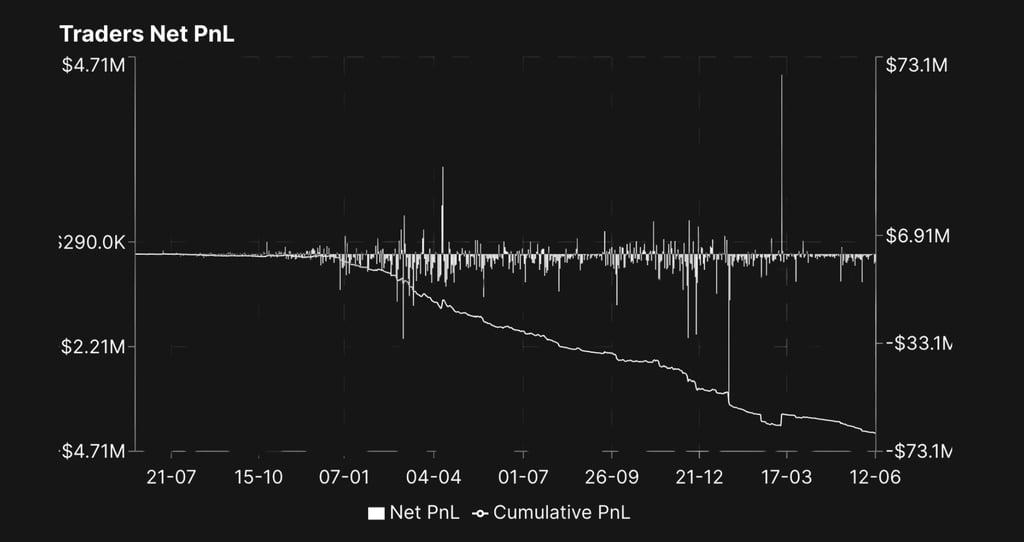

Traders Net PnL (Profit and Loss) shows the daily and cumulative net profits of all traders on the Hyperliquid platform, currently Cumulative PnL is negative $73.1 million, compared to a previous net loss of -$9.3 million year-over-year.
→ The total loss of all traders in the system has increased ~7.85 times compared to last year .
Cumulative PnL exhibits a steady negative slope with no signs of recovery . This is a normalized characteristic of derivatives market behavior , where:
Total system PnL = Trader profit + Transaction fee + Funding + Slippage
→ Most traders are shouldering all the fees + funding , and have no long term trading edge .
Trader loss means LP and platform stable profit , at the same time net loss increases:
Hyperliquid's HLP Pool records ROI ~+11.7% YTD 2025 .
Average monthly platform fees are ~$5.3M .
→ Hyperliquid is the platform with the highest trader loss , but comes with the best LP profit and performance in the industry.
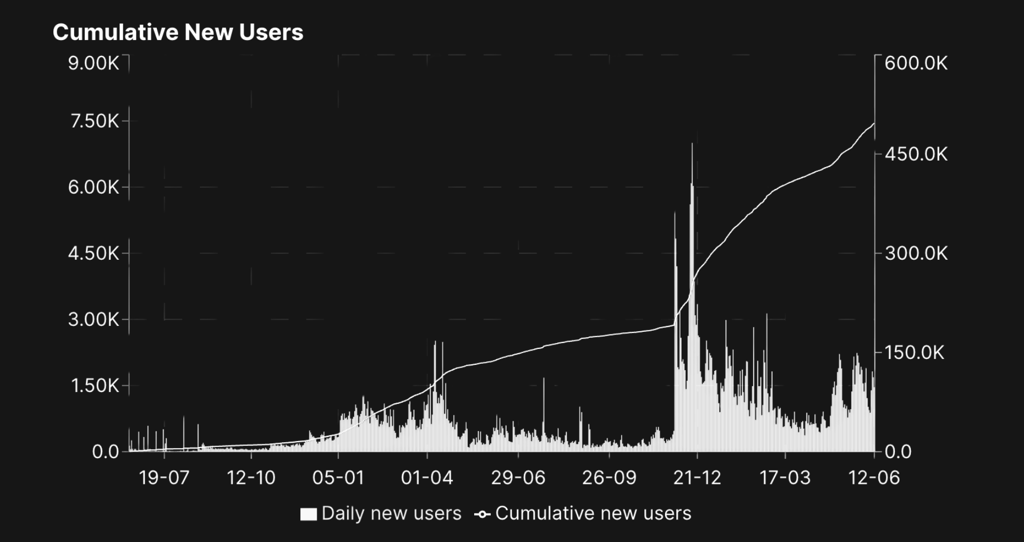

Hyperliquid's current cumulative user base is ~570,000 users, with an average of over ~2,950 users joining the platform every day.
In early 2025, there will be a peak of ~8,200 people/day .
The YoY 2024 figures are growing ~7.6x with YoY Growth of +660%, the platform is showing solid stability in terms of user base .
The user accumulation curve is increasing steadily – there is no sign of a sharp slowdown → reflecting the sustainability of the growth strategy.
There is no “boom then collapse” phenomenon → not an ecosystem growing thanks to temporary airdrop farming.
According to Metcalfe's (1995) theory, the value of a network is proportional to n² , where n is the number of users. With a 7.6x increase in users, the cumulative network growth effect is 57.76x.
This is why the platform has achieved deeper liquidity , lower spreads , and ~+8.9x trading volume growth year-over-year (Dune data – 06/14/2025).
Hyperliquid is redefining the standard of user growth in the DeFi derivatives space. Not only is it growing rapidly in quantity, but it is also growing sustainably in user quality.
Outstanding Projects In The Ecosystem
The Hyperliquid ecosystem in Q1/2025 has diversified, with many projects from DeFi, meme tokens, to technology solutions. Here are some typical projects:
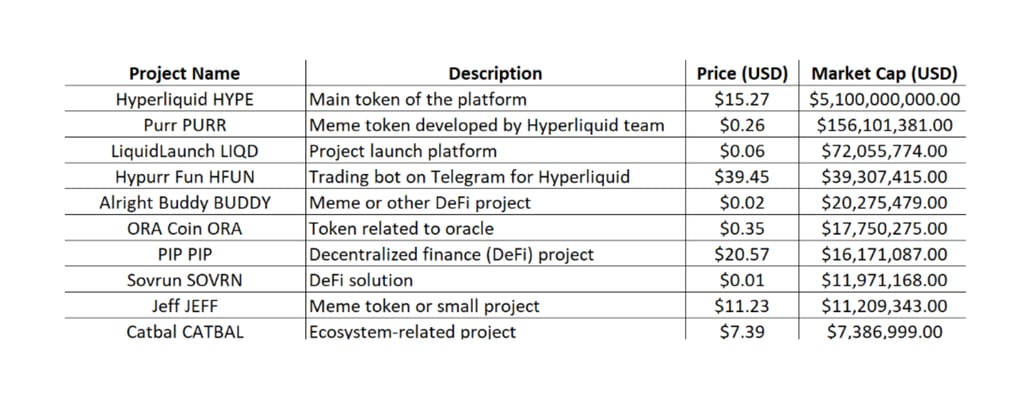

These projects show the diversity of the Hyperliquid ecosystem, from the main token HYPE to meme projects like Purr and Jeff, as well as DeFi solutions like LiquidLaunch and Hypurr Fun.
HyperLend is a decentralized lending platform designed to optimize efficiency in lending and borrowing transactions of cryptocurrencies.
HyperLend is built on Hyperliquid's EVM blockchain, HyperLend provides secure, transparent and highly liquid financial services. The project's goal is to develop an infrastructure that is comparable to modern traditional banking platforms, while still maintaining the decentralization and transparency of a Dapp on the Block Chain.
Prospects and challenges for this L1
With HyperEVM and spot markets, Hyperliquid is on track to become one of the leading DeFi platforms. A post on X on February 8, 2025 predicted that Hyperliquid will “take over the perpetuals market” and reach billions of dollars in revenue in the next 12-18 months.
User growth (388,000 users) and transaction volume ($1 trillion) show strong expansion potential.
Ecosystem projects like Purr and LiquidLaunch are gaining traction, adding diversity and vitality to Hyperliquid.
Hyperliquid needs to attract more developers and DApps to compete with established platforms like Ethereum and Solana.
HyperEVM bridges, despite being multi-sig secured, are still vulnerable to attacks, as seen in major hacks in the past (Wormhole, Ronin).
Tightening regulations in the crypto space could impact Hyperliquid's growth, especially as the platform expands into international markets.
Is Hyperliquid a good investment opportunity?
Hyperliquid boasts cutting-edge technology, fast transaction speeds, and an on-chain order book model, which sets it apart from other DeFi platforms like dYdX and GMX. With a sound tokenomics model, including deflation (burning transaction fees) and staking, HYPE has the potential to increase in price as the ecosystem expands.
In short, Hyperliquid is a potential but new project, investors should monitor the development of the ecosystem, liquidity and applicability of HYPE token before making an investment decision.
The following factors need to be monitored in 2025-2026 :
Ecosystem growth and number of new DApps.
Impact of HYPE token unlock schedule.
Technological improvements, especially cross-chain bridge security.
Crypto market developments and legal regulations.
What does Hyperliquid show us?
The Hyperliquid ecosystem in Q1 2025 has demonstrated its great potential to become a giant in the DeFi space. With the launch of HyperEVM, expansion of spot trading, and impressive numbers in terms of users and trading volume, Hyperliquid is attracting attention from both investors and developers.
The HYPE token, with a $13 billion market cap and deflationary mechanism, is a bright spot in the ecosystem. However, to maintain its growth momentum, Hyperliquid needs to continue investing in security, attracting DApps, and navigating regulatory challenges.
Hyperliquid is not just a DEX, but a promising ecosystem that is poised to shape the future of DeFi. Stay tuned so you don't miss out on the opportunities this platform brings!
Once again we give our opinion on potential projects in the crypto market. This is not investment advice, consider your portfolio. Disclaimer: The views expressed in this article are solely those of the author and do not represent the platform in any way. This article is not intended to be a guide to making investment decisions.
API & Data : Hyperliquid Foundation
Compiled and analyzed by HCCVenture and WHAT Exchange
Join HCCVenture here: https://linktr.ee/holdcoincventure
Explore HCCVenture group
HCCVenture © 2023. All rights reserved.


Connect with us
Popular content
Contact to us
E-mail : holdcoincventure_contact@hccventure.com
Register : https://linktr.ee/holdcoincventure
Disclaimer: The information on this website is for informational purposes only and should not be considered investment advice. We are not responsible for any risks or losses arising from investment decisions based on the content here.


TERMS AND CONDITIONS • CUSTOMER PROTECTION POLICY
ANALYTICAL AND NEWS CONTENT IS COMPILED AND PROVIDED BY EXPERTS IN THE FIELD OF DIGITAL FINANCE AND BLOCKCHAIN BELONGING TO HCCVENTURE ORGANIZATION, INCLUDING OWNERSHIP OF THE CONTENT.
RESPONSIBLE FOR MANAGING ALL CONTENT AND ANALYSIS: HCCVENTURE FOUNDER - TRUONG MINH HUY
Read warnings about scams and phishing emails — REPORT A PROBLEM WITH OUR SITE.
